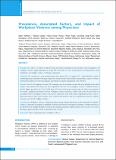Please use this identifier to cite or link to this item:
https://hdl.handle.net/20.500.14356/939| Title: | Prevalence, Associated Factors, and Impact of Workplace Violence among Physicians |
| Authors: | Adhikari, Biplov Subedi, Roshan Thakur, Rahul Kumar Thapa, Milan Karki, Sauharda Singh Dhungana, Bibek Devkota, Amrit KC, Bibek Thakurathi, Mohan Bhattarai, Adheesh Ray, Barun Kumar Phuyal, Bijay Sharma, Prabhat Devkota, Saugat Adhikari, Jog |
| Citation: | AdhikariB., SubediR., ThakurR. K., ThapaM., KarkiS. S., DhunganaB., DevkotaA., KCB., ThakurathiM., BhattaraiA., RayB. K., PhuyalB., SharmaP., DevkotaS., & AdhikariJ. (2023). Prevalence, Associated Factors, and Impact of Workplace Violence among Physicians. Journal of Nepal Health Research Council, 20(3), 636-644. https://doi.org/10.33314/jnhrc.v20i3.4008 |
| Issue Date: | 2022 |
| Publisher: | Nepal Health Research Council |
| Keywords: | Abuse Nepal Physicians Workplace violence |
| Series/Report no.: | July-Sep, 2022;4008 |
| Abstract: | Abstract Background: There is a dearth of objective data and studies pertaining to the prevalence and consequences of workplace violence against physicians in Nepal. This study aims to assess the prevalence, associated factors, and implications of workplace violence on Nepalese physicians. Methods: We conducted a cross-sectional study from March 2021 to August 2021. Nepal Medical Council-certified physicians currently working in Nepal were included in the study. Baseline characteristics, types of violence experienced, patterns, psychosocial impacts, and changes in patient management were collected. Results: Out of 318 responses received, 302 responses met the inclusion criteria and were included in the final analysis. One-hundred and ninety (62.9%) respondents had ever faced workplace violence. Madhesh Province had the highest prevalence (81.5%). Verbal abuse (93.2%) was the most common type of violence encountered. We found a significant association between workplace violence and hours worked each week. We also found an association between workplace violence and years of experience. Our study found a significant increase in stress/depression/anxiety/idea of persecution, sense of defeat, job turnover, and loss of productivity/income with the increase in severity of workplace violence. Conclusions: Workplace violence is largely prevalent among Nepalese physicians. In the aftermath of workplace violence, a physician can undergo a multitude of adverse psychosocial consequences leading to a further decrease in productivity. More insights through research, formal training, and policy implementation are necessary to overcome this largely ignored problem of the medical fraternity in Nepal. Keywords: Abuse; Nepal; physicians; workplace violence. |
| Description: | Original Article |
| URI: | http://103.69.126.140:8080/handle/20.500.14356/939 |
| ISSN: | Print ISSN: 1727-5482; Online ISSN: 1999-6217 |
| Appears in Collections: | Vol 20 No 3 Issue 56 july-Sep, 2022 |
Files in This Item:
| File | Description | Size | Format | |
|---|---|---|---|---|
| 4008-Manuscript-30769-1-10-20230314.pdf | Fulltext Article. | 228.73 kB | Adobe PDF |  View/Open |
Items in DSpace are protected by copyright, with all rights reserved, unless otherwise indicated.
